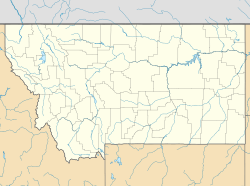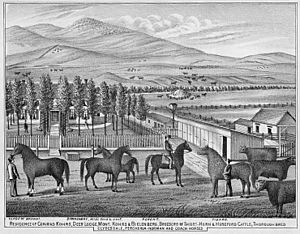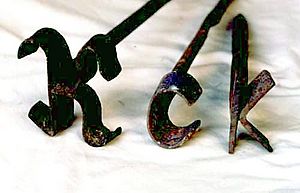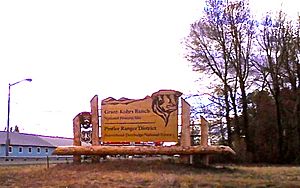Grant–Kohrs Ranch National Historic Site facts for kids
|
Grant–Kohrs Ranch National Historic Site
|
|
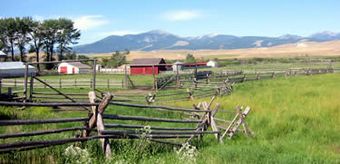
Grant–Kohrs Ranch
|
|
| Location | Powell County, Montana, USA |
|---|---|
| Nearest city | Deer Lodge, MT |
| Area | 1,618 acres (6.55 km2) |
| Built | 1863 |
| Visitation | 27,219 (2023) |
| Website | Grant–Kohrs Ranch National Historic Site |
| NRHP reference No. | 72000738 |
Quick facts for kids Significant dates |
|
| Designated NHLD | December 19, 1960 |
| Designated NHS | August 25, 1972 |
The Grant–Kohrs Ranch National Historic Site is a special place that helps us remember the history of the Western cattle industry. It was created in 1972. This ranch shows us how cattle ranching grew from the 1850s all the way to more recent times.
A Canadian fur trader named Johnny Grant started the original ranch in 1862. It was located in Montana, near the Clark Fork river. Later, a famous cattleman named Conrad Kohrs took over and made the ranch much bigger. Today, the National Park Service keeps this 1,618-acre historic site running as a real, working ranch. It's like stepping back in time!
Contents
Meet Johnny Grant: The Ranch's First Owner
Johnny Francis Grant was born far away in Canada. When he was a teenager, he joined his father, who worked for a big fur trading company. There, Johnny learned all about trading.
However, the fur trade started to slow down. So, Johnny and his brother began trading with travelers heading west on the Oregon Trail. He had a clever idea: he would trade one healthy cow or horse for two tired ones from the travelers. Then, he would feed and rest the tired animals. The next year, he would trade them again! This is how he got into the cattle business.
Starting a Ranch in Deer Lodge Valley
In 1857, Johnny Grant started using the Deer Lodge Valley to graze his cattle during the winter. He liked the area so much that he decided to build a permanent ranch there in 1862. He even convinced other traders to settle nearby, and that's how the town of Cottonwood began (which later became Deer Lodge).
Johnny was successful at first. But when gold miners arrived, things got difficult. Johnny spoke French, and most of the new miners spoke English. He felt that people took advantage of him in business deals. Because of this, he decided to sell his ranch. In 1866, he sold it to Conrad Kohrs for $19,200 and moved back to Canada.
Conrad Kohrs: Montana's Cattle King
Conrad Kohrs was born in Germany in 1835. When he was 22, he became a citizen of the United States. He first went to California during the gold rush, then to Canada, and finally arrived in Montana in 1862. He never found gold himself, but he became very rich by selling beef to the miners.
Kohrs grew his cattle business until he owned an amazing 50,000 cattle! His herds grazed on about 10 million acres of land.
Surviving a Harsh Winter
However, Kohrs faced a huge challenge during the severe winter of 1886–1887. More than half of the cattle in the Northwest died because of the brutal cold and lack of food. Many cattlemen went bankrupt. But Kohrs was smart and managed to get a large loan from his banker. He adapted to the changing times and paid off the loan in just four years.
Conrad Kohrs and his half-brother, John Bielenberg, started using more modern ranching methods. They bought special purebred cattle for breeding, fenced their rangeland, and grew and stored fodder (food for animals). Because of his success, Kohrs became known as "Montana's Cattle King."
John Bielenberg was also very important to the ranch. He came to Montana in 1864 to help with a butcher shop. Bielenberg was especially good with horses. He bred strong horses that could cover long distances quickly, which was very helpful for gathering cattle spread across huge areas. Together, Kohrs and Bielenberg were a very successful team for over 50 years.
The End of the Open Range Era
The winter of 1886–1887 was one of the worst ever in Montana. Ranchers who let their herds roam freely on the open range lost up to 90% of their cattle. Temperatures stayed far below zero for weeks. Many ranchers in Montana went out of business that summer. This harsh winter showed that the old way of open-range ranching was coming to an end.
Grant–Kohrs Ranch Joins the National Park Service
In the 1960s, the National Park Service started looking for more historic places to protect. The Grant–Kohrs Ranch was one of the places recommended to become a National Historic Landmark. Con Warren, who owned the ranch at the time, wanted to sell part of it to the National Park Service.
In 1970, an agreement was made. The ranch would be sold to the Park Service, but it would continue to be run as a living ranch. This meant visitors could see how a real ranch operated. The initial purchase included 130 acres. Later, the National Park Foundation bought another 1,180 acres, giving the National Park Service control of the site.
In August 1972, the U.S. Congress officially created the Grant–Kohrs Ranch National Historic Site. Its purpose was to help people understand the history of the frontier cattle era, preserve the ranch, and share its important stories with future generations. The site was officially added to the National Register of Historic Places in 1972.
Throughout the 1970s, the National Park Service bought more land from Conrad Warren. They also fixed up parts of the ranch and added things for visitors, like a visitor center and walking trails. In 1974, the ranch became its own independent unit within the National Park Service, with its own staff and budget. A special opening ceremony was held on July 17, 1977, and visitors were welcomed to the new site.
Grant–Kohrs Ranch Today
Today, the Grant–Kohrs National Historic Site is managed by the National Park Service. It's a popular place to visit in Deer Lodge, Montana, and tours are free!
The National Park Service runs it as a living history ranch. This means they try to do things as they would have been done in the 19th century. They use draft horse teams to cut hay, and blacksmiths on site make horseshoes for the horses. It's a great way to see history come alive!
Exploring the Ranch Properties
The ranch includes many historic buildings and areas that show what life was like on a working cattle ranch. Visitors can explore the main ranch house, barns, and other structures. The site helps everyone understand the daily life and hard work involved in the cattle industry of the past.
See also


